
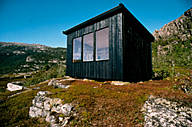
By Andreas Schelske.
Ever since electronic media were declared to be the message, the term ‘medium’ has been used to mean the fundamental substance that carries forms, of whatever kind. But what does the medium as message communicate? The answer depends onthe degree of tolerance exhibited by the medium with respect to form. No medium accepts every form which it is expected to carry: it is receptive only to those forms which are compatible with it, and resists the remainder, making it insensitive to alien matter. This characteristic of media suggests the way in which modernism has disburdened itself of the ambiguity that surrounds the matter. It has, modernistically, reduced this ambiguity to a uniformity of communication possibilities, in order to maintain the receptiveness of any given medium solely to those forms with which it can continue to cope. Thus the message of a medium inheres in its tolerance to forms of communication.
Ólafur Gíslason deals with media. In spaces of interest to the public he installs means of communication which serve to disseminate private forms. As this implies, his subject, the installation itself, is that of media which attempt to escape modernistic limitations by encompassing more than is contained in their individual elements. Although on the face of it Gíslason´s media consist of bulletin boards, paper writing surfaces, push pins, and drawing and painting materials, these things are potentiated by association with various other contexts, which in turn function as media.
The initial work in the series Gíslason has devoted to media was set up in Tjeldsund, Norway. The project, titled ‘Media Thule’ has continued since 1994. ‘Media Thule’ consits of a small wooden cabin whose three large windows present a view of what is going on outside, in the context of the natural surroundings. The aesthetic situation, apart from the sparse furnishings of the cabin, is established by a variety of painting utensils found there. The cabin is open to all who wish to enter, and offers an opportunity for free visual expression the results of which may be left on one of the bulletin. Assuming an uninterrupted concentration on one´s own ideas or the scenery outside, it is easy to imagine why the combination of natural landscape and individual seclusion eridently places very few restrictions on cummunicative forms.
Gíslason´s second piece with a media focus was done in the St. Pauli district of Hamburg, in the course of six months in 1995. This time the publicly accessible spaces were nine restaurants and inns, each of which contained a simple writing desk attached to the wall, and painting and drawing materials like those described above. In keeping with the context of the restaurants and the neighbourhood, Gíslason titled the installation ‘Medium St. Pauli’. In this case the participants risual expressions were by no means so thoughtful or carefree as in the earlier project. The configurations found on the sheets pinned to the board were often calligraphic or textual in character, and more frequently nervous and excited than contemplative. Apparently the context, as medium, was conducive only to communications that could be formulated, emotionalized and interpreted within a brief time period. In addition, this context infuenced the content of the messages in the direction of basic urban concerns, needs, and perspectives.
One can only speculate about the results of Gíslason´s present media project ‘Myndmál Landspítalans’, which has been underway in five rooms at the Reykjavík Hospital since December 1995. It is even more difficult, at this writing, to predict the form his contribution to the 1996 Baltic Sea Biennale will take. We do know that Gíslason intends to glean information about the fields of production, trade, administration and services in Rostock under the title ‘Medium Rostock’. But a medium yet to be configurated does not represent an actual communication - it remains amorphous. Still, we can expect the Rostock work to be based on a factor essential to Gíslason´s approach: the way he contradicts the modernist concept of the medium by allowing his objects to be influenced by situations which provide something beyond the monotony of media consensus. To explain this, we might refer ‘Medium rostock’ back to a definition of the term ‘medium’ that derives from the context of its Latin origin and history.
In the structural history of Latin usage, the term ‘medium’ had a great variety of connotations which, for us, echo in sometimes unfamiliar transformations, such as: a) something intermediate, a midpoint or middle degree, centre; b) environment, daily life, a means or agency of communicating something, announcing to the public, taking someone to court, retreating from the profane world; c) something to the common benfit or for common use; d) a mean. Given this wide conceptual repertoire, it is apparent why Gíslason´s ‘Medium St. Pauli’ can be better elucidated by reference to the original senses of ‘medium’ than to those based on the simplifications of present-day usage. The artist´s installation lend form to a medium of expression, and they also employ already existing media, such as public life, centres, sign codes for common use, and the common good. All of these media remain receptive to forms which they tolerate in their midst. The forms that exist on the margins of our world construct will find no medium, no centerpoint , and will lose their public character, unless viewers´ ability to learn is encouraged. To this extent, the message of ‘Medium Rostock’ will depend on the tolerance exhibited by the ‘medium’ of the city of Rostock. The 1996 Baltic Sea Biennale itself, as its motto ‘Intro (-) Ductions’ indicates, is concerned with exploring the concept of mdia. It will present to the public some of the messages relayed back to the base from communication satellites in often erratic orbits in outer art space.
To what forms does Gíslason´s medium react sensitively, and to what forms less so? Without a doubt, it tends to be highly unreceptive to every form that styles itself aesthetic. Art cannot take effect within Gíslason´s medium. It boycotts every attempt on the part of creative people, savvy or not, to introduce ambitious art, because the banal bulletin boards force such productions to coexist with evidently non-artistic material. This marginalization of art in a context intended as a refuge for public expression is nothing unusual, after all, almost every work of art has resisted the urge of viewers to use it as a material medium for further work - defacing an aesthetic product is rarely allowed. Gíslason´s medium, in contrast, fairly invites scribbling and paint splattering, drawing and writing in every conceivable form. Not even vandalism can entirely destroy it. The amorphousness of the medium replies to attempts at destruction by non-resitance: physical violence may deform it, but can expunge it only at the expense of enormous effort.
In a sense, Gíslason´s work stands within the Western tradition, because it to relies on the public sphere as a medium for art. On the other hand, art has seldom served as a medium for public expression, as individual works of art are not normally produced by collective effort. Art appears in areas that are marginal to the collective centre. When the public attempts fo focus its efforts on a single thing, this usually entails a loss of individual focus so grave that public pressure can even lead to physical self-injury, as Princess Diana has recently confessed. Gíslason´s media attempt to avoid this loss of individual focus. By providin unfocused means of communication, they deprive the maintream arbiters of the chance to exert social control. For the openess of a medium permits an expression of individual creativity that is sovereign wth respect with respect to social systems. The open medium replaces the idea of the ‘open work of art’.
Admittedly, the persons who use the medium must pay a price for this individual sovereignty: a waiver of the artistic status of their products, which exist outside the art system. With ‘Medium Rostock’ Gíslason nevertheless hopes to make people feel like an artist does the creatice process begins. Feeling like an artist does not imply knowing what it is like to be an artist. All Gíslason intends is to make people aware of their free will, at the point at which they face the empty sheet, and overcome their horror vacum. They are encouraged to invent something that reflects their individuality, and to sense the frisson of artistic creation. This is the reason why Gíslason´s media are receptive to forms whose public expressions can be traced back to subjective volition.
The conscious indeterminacy of Gíslason´s work illustrates certain problems of orientation that beset our cultural sign media, despite their intention to further the coordination of activities. In their present form, these media no longer permit us to orient ourselves by reference to the past, but only by reference to the recorded data available at the present moment. The flux of time insures the unrepeatability of society and art. This situation is metaphorically implied in Gíslason´s ‘Medium Rostock’ for art and modern societies can no longer refer back to their history in an attempt to discover where they are going. The only thing art knows is that it has set itself the boundless task of leaving the past behind. Art does occasionally look back, but not with the intent, or even the possibility, of projecting final goals. Art remains in the middle of the reigning sensibility. It stands rooted without exception in the present moment, resisting the chance both to loak back and to look forward. It almost goes without saying that something that can be neither reconsidered nor predicted must be experienced, in the here and now, with our own eyes.
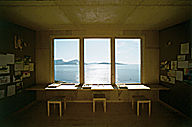
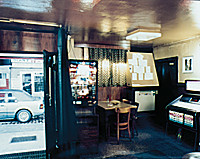
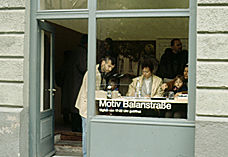
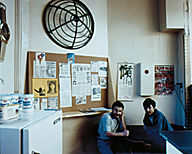
|
|
|
|
|
|
|
|